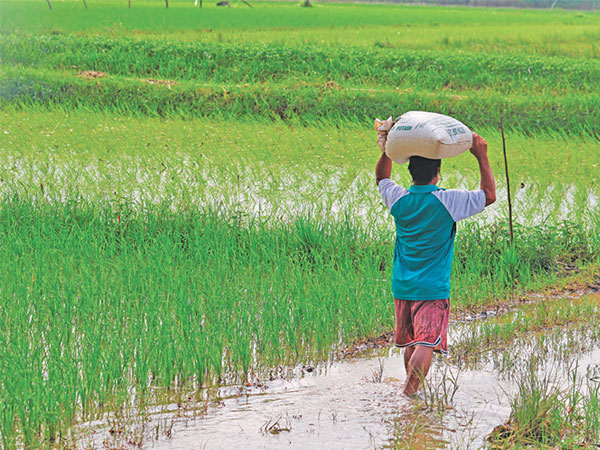 Instead of raising tariffs on rice imports, which could only push up prices, the government should focus on pursuing long-overdue structural reforms and addressing under-productivity in the agriculture sector, according to a public advocacy organization.
Instead of raising tariffs on rice imports, which could only push up prices, the government should focus on pursuing long-overdue structural reforms and addressing under-productivity in the agriculture sector, according to a public advocacy organization.
In a statement on Tuesday, the Foundation for Economic Freedom (FEF) said it strongly opposes the Department of Agriculture’s (DA) recent proposal to hike the tariffs on rice imports to 25 percent from the current 15 percent.
“Contrary to the stated aim of ‘stabilizing the market,’ a tariff hike on rice imports—alongside the looming threat of reinstating import quotas—would restrict supply and artificially drive prices up,” FEF said.
Limiting rice imports to 1 million metric tons will lead to a wide supply gap of more than 3 million metric tons. Given current productivity levels, FEF said domestic production will not be able to plug this deficit.
As a result, inflation will quicken by 1.2 to 1.4 percentage points, which FEF said is “a dangerous gamble” since rice makes up 9 percent of the Consumer Price Index basket. The poorest households also spend around 20 percent of their budget on rice alone.
“At a time when food inflation remains a top concern for millions of Filipino households, this move will only aggravate price pressures and set back the very gains achieved under the Rice Tariffication Law (RTL) of 2019,” FEF said.
The RTL brought in a rules-based trading system that brought down the average price of rice by P7 per kilo and reduced inflation volatility, dismantling a failed quota-based regime that historically caused price spikes and fostered rent-seeking behavior, it said.
“The problem in Philippine agriculture is not over-importation—but under-productivity. Protectionist measures like high tariffs or import caps will not solve this. They only serve to shield inefficient sectors from the need to reform,” it added.
To fix this enduring problem, FEF said long-overdue structural improvements must be pursued, including investing in irrigation, post-harvest facilities, mechanization, market linkages, research and development and land consolidation to enable economies of scale.
Aside from these, the outdated land market restrictions under the Comprehensive Agrarian Reform Law must also be removed.
FEF said land fragmentation, driven by a five-hectare ownership cap, a 10-year restriction on land transfers and layers of bureaucratic clearance requirements, has stunted productivity, discouraged investments and given rise to a new class of “landed poor.”
Citing data from the Philippine Statistics Authority, the average farm size shrank to 0.83 hectares in 2022 from 3.61 hectares in 1971.
Further, the agrarian reform program resulted in a 34-percent reduction in average farm size, a 17 percent drop in agricultural productivity and only a marginal 20 percent decline in the share of landless individuals, according to a study by economists Tasso Adamopoulos and Diego Restuccia in 2019.
FEF said targeted reforms, including the increase in landholding ceiling to 50 hectares from 5 hectares, removal of the 10-year restriction on land transferability and elimination of requirements for Department of Agrarian Reform (DAR) clearances in land transfers, relying instead on the Land Registration Authority’s (LRA) digital registry, should be adopted.
“These changes will allow farmers to scale up, modernize their operations, improve productivity, and attract a new generation of younger, more innovative farmers,” it said.
The group also urged the DA to abandon protectionist proposals that will only repeat earlier mistakes.
“Let us not sacrifice consumer welfare at the altar of misguided populism. Instead, let us double down on evidence-based, market-friendly reforms that lift both farmers and consumers through genuine productivity growth and open competition,” FEF said.
‘Unsustainable’
House Special Committee on Food Security Chairperson Rep. Raymond Adrian Salceda warned, however, that low rice prices may be unsustainable for local farmers—particularly rice producers.
“I fully commend President Ferdinand Marcos Jr. for stabilizing inflation and getting us out of the woods. Now that inflation has eased, especially in food prices, we can afford to go back to policies that give our local farmers a fighting chance,” Salceda said.
Food inflation posted an annual decline of 0.5 percent, driven mainly by a 15.9 percent drop in rice prices.
“That level of rice deflation is not sustainable for our farmers. It means farmgate prices are down while input costs are still high. This puts our food security at risk in the long run if farmers decide to plant less or shift to other crops,” Salceda said.
Salceda advocated for a phased rollback of the lowered rice import tariff, which was introduced at the height of last year’s inflation spike. Now that prices have stabilized, he argued, it is logical to restore protective policies that support local production.
“The purpose of the lower tariff was to bring prices down. Now that prices have dropped, it is only logical to restore tariffs to previous levels to support our rice farmers and maintain local production.”
Salceda vowed to work closely with the Department of Agriculture to strengthen rice farmer competitiveness and ensure they are not unfairly undercut by imports at a time when prices are already stable.














© Copyright 2025 The SSResource Media.
All rights reserved.